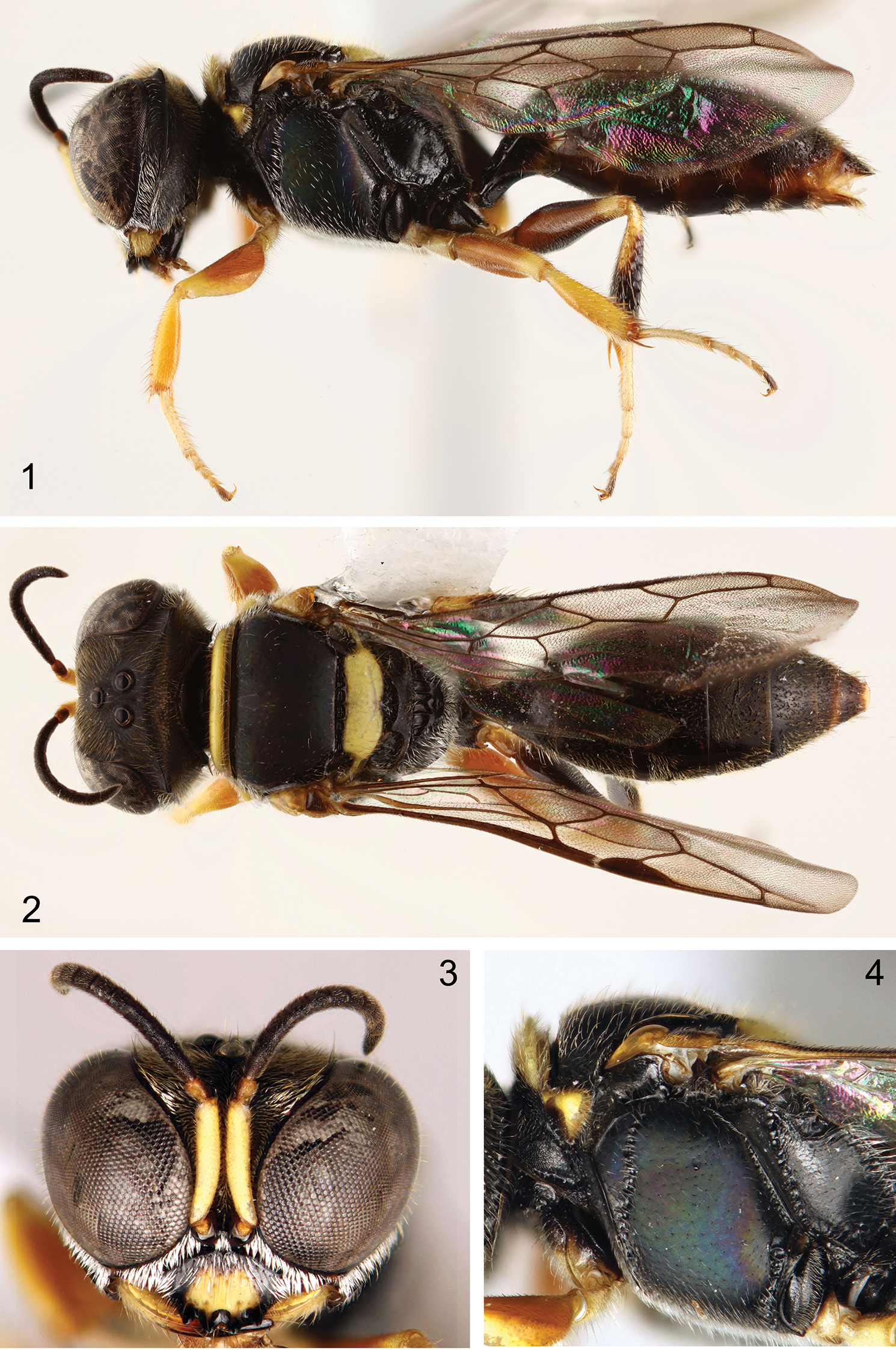






(C) 2011 Daniel J. Bennett. This is an open access article distributed under the terms of the Creative Commons Attribution License, which permits unrestricted use, distribution, and reproduction in any medium, provided the original author and source are credited.
For reference, use of the paginated PDF or printed version of this article is recommended.
A distinctive new species of the crabronine wasp genus Quexua Pate is described and figured from a single male collected from lowland Amazonian rain forest in southeastern Peru. Quexua cicra sp. n. is the only species in the genus known with a sessile metasoma.
Apoidea, apoid wasp, Crabroninae, Crabronini, new species, taxonomy
The Latin American crabronine genus Quexua consists of relatively small, dark wasps found from Costa Rica to the State of São Paulo in Brazil (
The following provides a description and figures for a new species of Quexuarecently captured in southeastern Peru. It represents the 17th species of the genus and the ninth known from Peru (
The single specimen known is deposited in the Museo Nacional de Historia Natural, Lima, Peru (MUSM). Terminology follows
Genus Quexua Pate, 1942
urn:lsid:zoobank.org:act:472F527A-D406-4DC7-B146-CBD03FEF3C3A
http://species-id.net/wiki/Quexua_cicra
Figs 1–4♂, Peru: Madre de Dios: CICRA Field Station, 12.5526°S, 70.1101°W, 295 m, 11–13.VII.2010, Chaboo team, ex. flight intercept trap (MUSM).
The sessile metasoma alone will serve to distinguish this species from its congeners (Figs 1–2). Also of diagnostic significance are the relatively long pubescence of the compound eyes (Fig. 3); mat sculpture and blue-green iridescence of the head, metanotum, and mesopleuron (Fig. 4); and lack of a carina along the inner orbit.
Male:Body length 7.3 mm (front of compound eye to apex of pygidial plate); head height 1.5 mm, width 1.8 mm; forewing length 4.8 mm (not including tegula); intertegular distance 2.0 mm (including tegulae). Antennal scape elongate, with a single, weak longitudinal carina on inner side of outer surface; flagellum 11-segmented, each article about as long as wide. Clypeus apically with four stout, rounded teeth of similar size (Fig. 3). Toruli separated by less than 1/2 width of torulus, positioned against epistomal sulcus, scapal basin shallow and ecarinate. Facial fovea inconspicuous, roughly size of mid ocellus. Ocellar triangle about as broad as high; mid ocellus slightly smaller than hind ocellus. Gena laterally with strong dorsoventral carina dorsally producing a rounded point. Vertex with narrow pit dorsomedially and low, rounded transverse swelling continuous with more prominent lateral carina of gena. Occipital carina present dorsally, laterally and ventrally; laterally expanded into a lamella and foveate along anterior side (not foveate dorsally), ventrolaterally pointed at a junction between a segment produced towards mandible (mandibular branch of occipital carina of
Black except following areas light brown: tegula, proximal 4/5 of fore and mid femora, inner surface of fore tibia, apical tarsomeres, and hind trochanter in part; darker brown are pedicel ventrally, palpi, wing veins, outer surface of hind femur over proximal 4/5 and metasoma laterally and ventrally; yellow areas are entire scape, clypeus largely (broadly over central area, margins black), mandible in proximal half, pronotum, pronotal lobe, mesoscutellum in full, fore coxa anteroventrally, mid coxa lateroventrally, hind coxa narrowly apicoventrally, trochanters, femora apically narrowly (extended basally on posterior surface of fore and meso femora), outer surfaces of fore and mid tibiae, basal 1/3 of outer side of hind femur, and preapical tarsomeres (Figs 1–3). Wings iridescent and mostly hyaline, browned along leading marginal areas of forewing apically. Mesopleuron (Fig. 4), metanotum and (to a lesser a degree) gena and vertex with a distinct blue-green iridescence.
Pubescence overall sparse, mostly off-white to silver, light brown on metasoma and dorsal portions of head and mesosoma; clypeus laterally with fairly dense silver setae, medially mostly bare except for about four prominent, fairly long, thin, brown setae; compound eyes with sparse yet distinctive, long setae (length equal to about half ocellus diameter) (Fig. 3); propodeum with moderately dense silver setae posterolaterally; wings moderately densely setose apically, less so basally; legs sparsely to moderately spinose, the latter particularly on hind tibia. Metasomal tergum I sparsely setose, remaining terga moderately setose, becoming more dense posteriorly; sterna II–VII sparsely setose posteriorly, with a few conspicuously long setae sublaterally.
Surface sculpture overall very fine. Gena, vertex, mesonotum, mesopleuron, mesoscutellum and metanotum dull mat, weakly and sparsely punctate (Fig. 2). Propodeum, metapleuron, legs, sterna (more or less) and terga nitid (characterization of the terga possibly in error, at least partially influenced by residue); tergum I smooth, sparsely and weakly punctate; sterna II–VII imbricate.
Female: Unknown.
Male holotype of Quexua cicra Bennett, sp. n. 1 Lateral habitus 2 Dorsal habitus 3 Facial aspect 4 Mesosoma in lateral view.
The specific epithet refers to the field station adjacent to the type locality of this species and is treated as a noun in apposition. CICRA (also known as Los Amigos Biological Station) is an acronym for Centro de Investigación Capacitación Río Los Amigos.
This is the first species of the genus known to have a sessile metasoma. In all others, the length of the first metasomal tergum is distinctly greater than its posterior breadth. Also notable, and possibly unique, are the widespread mat, iridescent sculpture and the length of pubescence of the compound eyes (at least much greater than the Quexuaspecies listed above). It is hoped that a female is soon captured and that biological observations of the genus at large will be made.
I am grateful to Caroline Chaboo, Choru Shin, Diana Silva, and Malena Vilchez for their efforts in the field; to Diana Silva, Mabel Alvarado, and Luis Figueroa for assistance obtaining permits; to Michael Engel for reading an early draft and supplying helpful comments; and to Volker Lohrmann and an anonymous referee for their careful reviews and useful suggestions. This is a contribution of the Division of Entomology, University of Kansas Natural History Museum.
